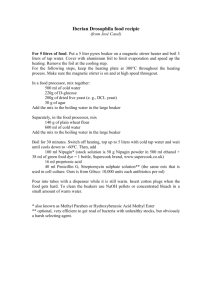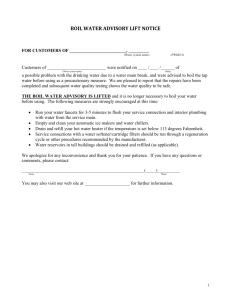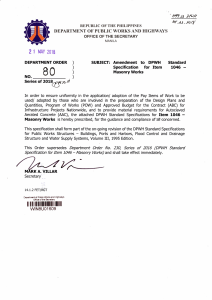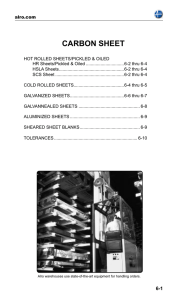Sc-G9(Phy)-Heat-3a-SpHtCap-9L
advertisement
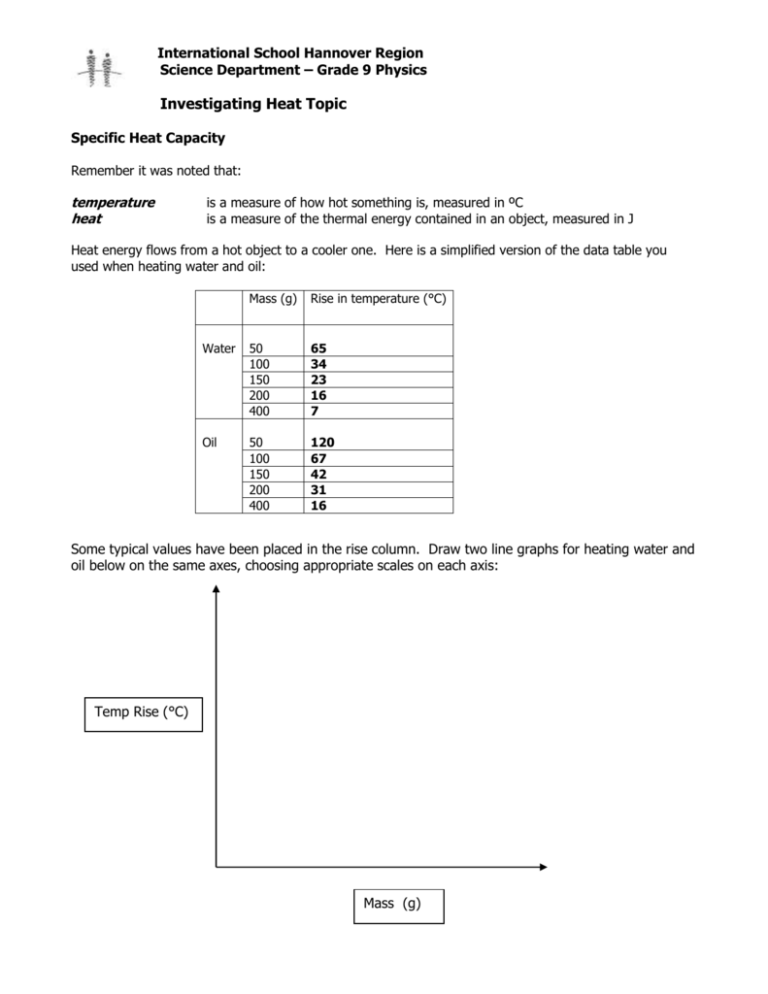
International School Hannover Region Science Department – Grade 9 Physics Investigating Heat Topic Specific Heat Capacity Remember it was noted that: temperature heat is a measure of how hot something is, measured in ºC is a measure of the thermal energy contained in an object, measured in J Heat energy flows from a hot object to a cooler one. Here is a simplified version of the data table you used when heating water and oil: Mass (g) Rise in temperature (°C) Water 50 100 150 200 400 65 34 23 16 7 Oil 50 100 150 200 400 120 67 42 31 16 Some typical values have been placed in the rise column. Draw two line graphs for heating water and oil below on the same axes, choosing appropriate scales on each axis: Temp Rise (°C) Mass (g) Specific Heat Capacity of a Substance (c) Note that: (a) the temperature rises get smaller as the mass rises, (b) the temperature rises were greater for oil than for water. The same amount of heat was used for all masses and substances. If this information is stated another way, we can say: The heat used to raise the temperature of a substance depends on the mass, the type of substance, and the temperature increase. The specific heat capacity of a substance (c) is a measure of how much heat energy it can hold. It is the energy needed to increase the temperature of 1 kg of the substance by 1 ºC. Different substances have different specific heat capacities. Here is a table with the specific heat capacities of some common materials. Specific Heat Capacities Table Substance J/kg/oC or J/kg/K Water (0 oC to 100 oC) 4186 Methyl Alcohol 2549 Ice (-10 oC to 0 oC) 2093 o Steam (100 C) 2009 Wood (typical) 1674 Soil (typical) 1046 Air (50 oC) 1046 Aluminum 900 Glass (typical) 837 Iron/Steel 452 Copper 387 Silver 236 Mercury 138 Gold 130 Table from: http://www.ac.wwu.edu/~vawter/PhysicsNet/Topics/Thermal/HeatCapTable.html You may need to use some of these values to answer the questions that follow. Note: (1) (2) (3) Water has a particularly high specific heat capacity. This makes water useful for storing heat energy, and for transporting it around buildings using central heating pipes, since on cooling 1 oC each kg transfers 4186 Joules to the air. Specific heat for water, ice, and steam are different. Metals generally have low specific heat capacities, and therefore require less heat to warm them up. 2 Energy Calculations Another way of putting the bold statement in the box above is Heat Energy gained or lost = specific heat capacity x mass × temperature change (J) (J/kg/ºC) (kg) (ºC) We can write this as an equation using symbols: H = c x m x ΔT You should be able to state, and use this equation relating energy to specific heat capacity. You may need to rearrange the equation in a test. Example Question: How much energy is needed to increase the temperature of 500 g of lead from 20 ºC to 45 ºC? The specific heat capacity of lead is 128 J/kg/ºC. Answer (Information given) (physics used) (calculation) kJ). Mass of lead = 500 ÷ 1000 = 0.5 kg Temperature change = 45–20 = 25 ºC H = c x m x ΔT = 0.5 × 128 × 25 = 1600 J (1.6 Test Bite: Write the answers to these two questions out on paper. Show any working you use. 1 The specific heat capacity of water is 4181 J/kg/°C and that of lead is 128 J/kg/°C. This means: A Lead melts at a low temperature. B More energy is needed to boil water than is needed to boil lead. C More energy is needed to heat water than is needed to heat the same mass of lead by the same amount. 2. Energy = mass x specific heat x temperature change. If the specific heat capacity of water is 4181 J/kg/°C, how much energy is needed to boil a kettle with 750g of water from 20°C? A 250.86 kJ B 25.086 kJ C 2508.6 kJ Edited from: http://www.bbc.co.uk/schools/gcsebitesize/science/ocr_gateway/energy_home/0_heating_houses1.shtml 2nd Example problem: How much heat is required to raise the temperature of the air in the lab from 12°C to 22°C? The room is 12m x 5m x 4m, and air has a density of approximately 1.2 kg/m3 at sea level. Solution: Heat required H = m x c x ΔT, (Info given) ΔT c m so we need values for ΔT, c, and m. = 22 – 12 = 10°C = 1046 J/kg/°C = density x volume = 1.2 x (12 x 5 x 4) kg = 288 kg 3 (bet you didn't realize it is this much mass!) Now So H = c x m x ΔT H = 1046 x 288 x 10 = ………………… J = ……………….. kJ 4 Write out your answers to the following questions from GCSE Science on paper, showing all your working. For question 4, remember that 1 watt (1W) is a power equivalent to 1 joule/second (J/s). The next two questions are more challenging! Questions from Longman GCSE Physics by B Arnold & Steve Woolley 5 Here are some further Exercises and Challenges to conclude this section. Answer them in full on paper. 6 Exercises & Challenges from Science World Book 2, by Stannard & Williamson 7
